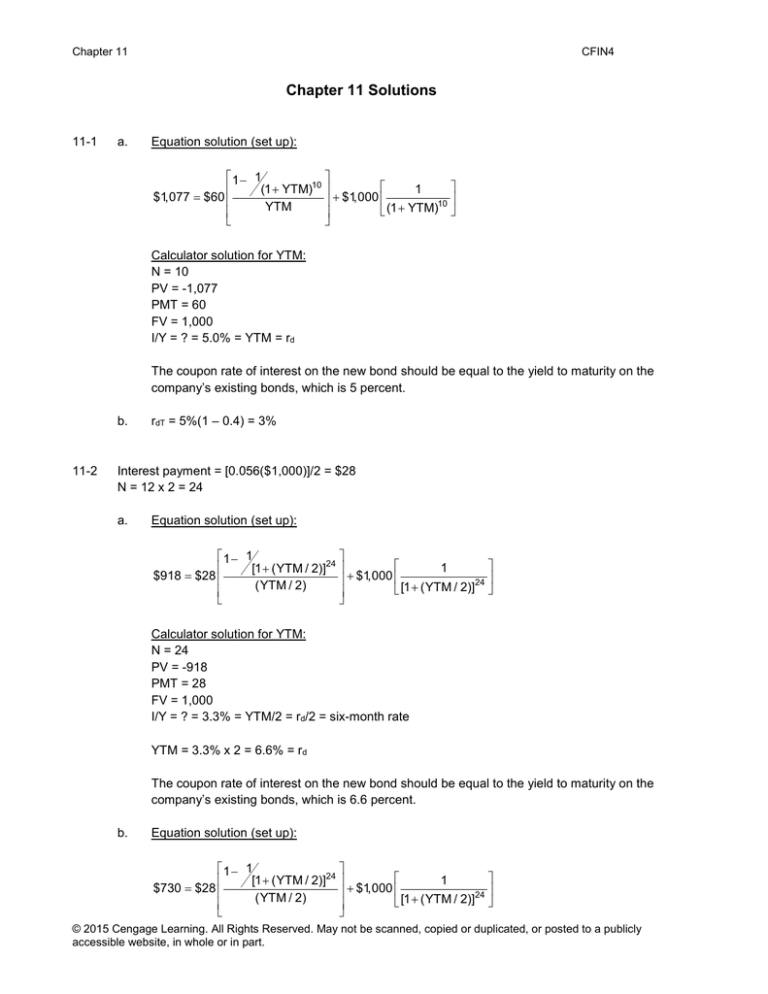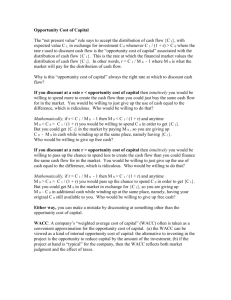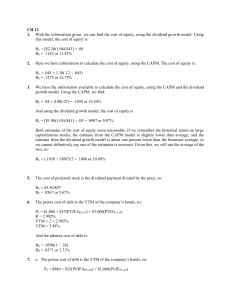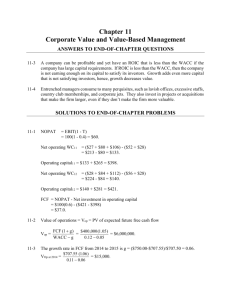
Chapter 11
CFIN4
Chapter 11 Solutions
11-1
a.
Equation solution (set up):
1 1
1
(1 YTM)10
$1,077 $60
$1,000
10
YTM
(1 YTM)
Calculator solution for YTM:
N = 10
PV = -1,077
PMT = 60
FV = 1,000
I/Y = ? = 5.0% = YTM = rd
The coupon rate of interest on the new bond should be equal to the yield to maturity on the
company’s existing bonds, which is 5 percent.
b.
11-2
rdT = 5%(1 – 0.4) = 3%
Interest payment = [0.056($1,000)]/2 = $28
N = 12 x 2 = 24
a.
Equation solution (set up):
1 1
1
[1 (YTM / 2)]24
$918 $28
$1,000
24
(YTM / 2)
[1 (YTM / 2)]
Calculator solution for YTM:
N = 24
PV = -918
PMT = 28
FV = 1,000
I/Y = ? = 3.3% = YTM/2 = rd/2 = six-month rate
YTM = 3.3% x 2 = 6.6% = rd
The coupon rate of interest on the new bond should be equal to the yield to maturity on the
company’s existing bonds, which is 6.6 percent.
b.
Equation solution (set up):
1 1
1
[1 (YTM / 2)]24
$730 $28
$1,000
24
(YTM / 2)
[1 (YTM / 2)]
© 2015 Cengage Learning. All Rights Reserved. May not be scanned, copied or duplicated, or posted to a publicly
accessible website, in whole or in part.
Chapter 11
CFIN4
Calculator solution for YTM:
N = 24
PV = -730
PMT = 28
FV = 1,000
I/Y = ? = 4.7% = YTM/2 = rd/2 = six-month rate
YTM = 4.7% x 2 = 9.4% = rd
11-3
Dividend = 0.05($120) = $6
rps =
11-4
D
$6
0.08 8.0%
NP0 $75
a.
Net proceeds to the firm = $50(10,000)(1 – 0.05) = $500,000(0.95) = $475,000
b.
rps =
D
$4.75
$4.75
0.10 10.0%
NP0 $50(1 0.05) $47.50
11-5
rs = rRF + (rM - rRF)βs = 3.5% + (9.0% - 3.5%)1.4 = 11.2%
11-6
rs = rRF + (rM - rRF)βs = = rRF + (RPM)βs = 5% + (7%)2.0 = 19.0%
11-7
Equation solution (set up) for rd:
1 1
1
[1 (YTM / 2)]12
$900 $20
$1,000
12
(YTM / 2)
[1 (YTM / 2)]
Calculator solution for YTM:
N = 12
PV = -900
PMT = 20
FV = 1,000
I/Y = ? = 3.0% = YTM/2 = rd/2
rd = 3% x 2 = 6%
rs = 6% + Risk premium = 6% + 4% = 10% (using the mid-point risk premium)
© 2015 Cengage Learning. All Rights Reserved. May not be scanned, copied or duplicated, or posted to a publicly
accessible website, in whole or in part.
Chapter 11
11-8
CFIN4
g = 4%
P0 = $34
D0 = $4.25
F = 8.25%
a.
Cost of retained earnings, rs
rs
b.
$4.25(1.04)
$4.42
0.04
0.04 0.17 17.0%
$34
$34
Cost of new equity, re
re
11-9
D̂1
g
P0
D̂1
g
NP0
$4.25(1.04)
$4.42
0.04
0.04 0.182 18.2%
$34(1 0.085)
$31.11
g = 0%
P0 = $50
D0 = $6
F = 7%
a.
Cost of retained earnings, rs
rs
b.
D̂1
g
P0
$6(1.0)
$6
0.0
0.12 12.0%
$50
$50
Cost of new equity, re
re
D̂1
g
NP0
$6(1.0)
$6
0.0
0.129 12.9%
$50(1 0.07)
$46.50
© 2015 Cengage Learning. All Rights Reserved. May not be scanned, copied or duplicated, or posted to a publicly
accessible website, in whole or in part.
Chapter 11
11-10
CFIN4
g = 5%
P0 = $28
D0 = $2.40
re = 15%
F=?
re
ˆ
ˆ
D
D
1
1
g
g
NP0
P0 (1 F)
$2.40(1.05)
0.05 0.15
$28(1 F)
$2.52
0.05 0.15
$28(1 F)
1
0.09
0.10
1 F
0.09 0.10(1 F) 0.10 0.10F
F
0.10 0.09
0.10
0.10
Check: If flotation costs equal 10 percent, the cost of new equity, r e, is:
re
11-11
D̂1
g
P0 (1 F)
$2.40(1.05)
$2.52
0.05
0.05 0.15 15.0%
$28(1 0.1)
$25.20
g=?
P0 = $32
D̂1 = $3.36
re = 15.5%
F = 6.5%
Solve for the firm’s growth rate:
rs
D̂1
$3.36
g
g 0.155
P0
$32
g 0.155 0.105 0.05
© 2015 Cengage Learning. All Rights Reserved. May not be scanned, copied or duplicated, or posted to a publicly
accessible website, in whole or in part.
Chapter 11
CFIN4
Cost of new equity, re:
re
11-12
11-13
ˆ
ˆ
D
D
1
1
g
g
NP0
P0 (1 F)
$3.36
$3.36
0.05
0.05 0.162 16.2%
$32(1 0.065)
$29.92
Break points associated with the debt:
BP1
$450,000
$750,000
0.6
BP2
$750,000
$1,250,000
0.6
There are two break points associated with the new funds—(1) when more than $240,000 in debt is
issued and (2) when new common equity must be issued.
BPDebt
BPRE
$240,000
$800,000
0.3
$560,000
$800,000
0.7
According to this information, Western’s WACC will increase when it raises more than $800,000 in total
funds because both the cost of debt and the cost of equity will increase beyond this point. In other
words, the break point for debt and the break point for equity occur at the same level of funds.
11-14
11-15
a.
WACC1 = wd(rdT) + ws(rs) = 0.4[5%(1 – 0.35)] + 0.6(8%) = 6.1%
b.
WACC2 = wd(rdT) + ws(re) = 0.4[5%(1 – 0.35)] + 0.6(11%) = 7.9%
wd = 20%
rdT = 3.5%
wps = 30%
rps = 6.0%
ws = 50%
rs = 10.2%
Retained earnings = $100,000
Funding needs = $220,000
re
= 12.4%
The retained earnings break point must be computed to determine whether a new common stock issue
is required to raise the $220,000 in total funds that Killer Burgers needs.
BPRE
$100,000
$200,000
0.5
© 2015 Cengage Learning. All Rights Reserved. May not be scanned, copied or duplicated, or posted to a publicly
accessible website, in whole or in part.
Chapter 11
CFIN4
Killer Burgers needs to raise $220,000, but it can only raise a total of $200,000 before new common
stock must be issued. As a result, the firm must issue new stock.
Alternative solution: If Killer Burgers raises $220,000, following is the breakdown of how the funds will
be raised:
Debt = $220,000(0.2) = $44,000
Preferred stock = $220,000(0.3) = $66,000
Common equity = $220,000(0.5) = $110,000
Total amount = $220,000
Because the amount of funds that will be raised using common equity is greater than the $100,000
expected increase in retained earnings, new common stock must be issued.
When new common stock must be issued, Killer’s WACC is:
WACC = 3.5%(0.2) + 6.0%(0.3) + 12.4%(0.5) = 8.7%
11-16
wd = 60%
rd = 5.0%
wps = 10%
rps = 7.0%
ws = 30%
rs = 11.0%
Retained earnings = $26,000
Funding needs = $85,000
Marginal tax rate = T = 30%
re
= 13.0%
The retained earnings break point must be computed to determine whether a new common stock issue
is required to raise the $85,000 in total funds that FC needs.
BPRE
$26,000
$86,667
0.3
FC needs to raise $85,000, and it can raise up to a total of $86,667 before new common stock must be
issued. As a result, the firm does not need to issue new stock.
Alternative solution: If FC raises $85,000, following is the breakdown of how the funds will be raised:
Debt = $85,000(0.6) = $51,000
Preferred stock = $85,000(0.1) =
$8,500
Common equity = $85,000(0.3) = $25,500
Total amount = $85,000
Because the amount of funds that will be raised using common equity is less than the $26,000 expected
increase in retained earnings, new common stock does not need to be issued.
When new common stock must be issued, FC’s WACC is:
WACC = [5%(1 – 0.3)](0.6) + 7.0%(0.1) + 11%(0.3) = 6.1%
© 2015 Cengage Learning. All Rights Reserved. May not be scanned, copied or duplicated, or posted to a publicly
accessible website, in whole or in part.
Chapter 11
11-17
CFIN4
The retained earnings break point must be computed to determine at what point new common stock
must be issued:.
BPRE
$24,000
$40,000
(1 0.4)
Based on this information, we know that WACC = 14 percent as long as the total capital budget is less
than $40,000. If the capital budget is greater than $40,000, WACC = 17 percent. The following table
applies this information to the three projects Lazy Loungers is evaluating:
Project
A
B
C
Cost
$10,000
15,000
25,000
Costs
$10,000
$25,000
$50,000
IRR
21.0%
20.0
16.0
WACC
14.0%
14.0
17.0
Acceptable?*
Yes, IRR > WACC
Yes, IRR > WACC
No, IRR < WACC
* Indicates whether the project in the row and the project(s) in the row(s) above are acceptable.
Projects A and B should be purchased.
11-18
The retained earnings break point must be computed to determine at what point new common stock
must be issued:.
BPRE
$230,000
$287,500
0.8
As a result, following are the WACCs when no new stock must be issued and when new common stock
must be issued:
Capital budget < $287,500; no new stock is needed:
WACC = 0.2(4.0%) + 0.8(10.0%) = 8.8%
Capital budget > $287,500; new stock must be issued:
WACC = 0.2(4.0%) + 0.8(12.5%) = 10.8%
. The following table applies this information to the projects OTC is evaluating:
Project
S
L
Cost
$150,000
140,000
Costs
$150,000
$290,000
IRR
12.0%
10.0
WACC
8.8%
10.8
Acceptable?*
Yes, IRR > WACC
No, IRR < WACC
* Indicates whether the project in the row and the project(s) in the row(s) above are acceptable.
Only Project S should be purchased.
© 2015 Cengage Learning. All Rights Reserved. May not be scanned, copied or duplicated, or posted to a publicly
accessible website, in whole or in part.
Chapter 11
11-19
CFIN4
The WACCs are:
Total Amount Raised
$1 – $520,000
520,001 –
745,000
Over 745,000
WACC
11.0%
12.5
15.2
Using these WACCs, the following table summarizes the capital budgeting decision:
Project
1
3
2
4
Cost
$214,000
$214,000
$214,000
$214,000
Costs
$214,000
$428,000
$642,000
$856,000
IRR
19.0%
18.0
15.0
14.0
WACC
11.0%
11.0
12.5
15.2
Acceptable?*
Yes, IRR > WACC
Yes, IRR > WACC
Yes, IRR > WACC
No, IRR < WACC
* Indicates whether the project in the row and the project(s) in the row(s) above are acceptable.
Projects 1, 2, and 3 should be purchased.
11-20
(1)
Compute the break points:
BPRE
$1,300,000
$2,000,000
0.65
BPDebt
(2)
$420,000
$1,200,000
0.35
Compute the WACC for each interval of funds:
Total Funds: $1 to $1,200,000 (first break point); at the maximum amount of this interval,
Debt
= 0.35($1,200,000) = $420,000
Equity = 0.65($1,200,000) = $780,000
WACC1 = [5%(1 – 0.4)](0.35) + 12%(0.65) = 8.85%
Total Funds: $1,200,001 to $2,000,000 (second break point); at the maximum amount of this
interval,
Debt
= 0.35($2,000,000) = $700,000
Equity = 0.65($2,000,000) = $1,300,000
WACC1 = [7%(1 – 0.4)](0.35) + 12%(0.65) = 9.27%
© 2015 Cengage Learning. All Rights Reserved. May not be scanned, copied or duplicated, or posted to a publicly
accessible website, in whole or in part.
Chapter 11
CFIN4
Total Funds: Greater than 2,000,000; if the entire project is funded at $2.6 million,
Debt
= 0.35($2,600,000) = $910,000
Equity = 0.65($2,600,000) = $1,690,000
WACC1 = [7%(1 - 0.4)](0.35) + 14%(0.65) = 10.57%
(3)
Determine how much of the project should be purchased.
Because the project’s IRR = 9.2%, Tri-Q should purchase the project until the WACC = 9.2%,
which means that $2,000,000 of the project should be purchased. The entire project cannot be
purchased because the total cost is $2,600,000, and raising this amount of funds has a WACC =
10.57%, which means IRR < WACC at this point.
© 2015 Cengage Learning. All Rights Reserved. May not be scanned, copied or duplicated, or posted to a publicly
accessible website, in whole or in part.






